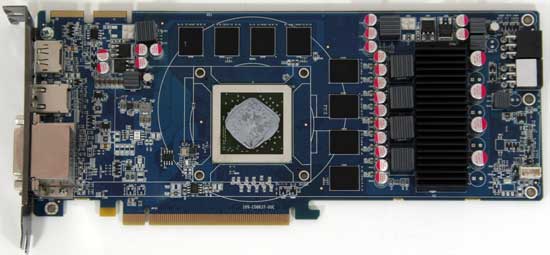
Original Link: https://www.anandtech.com/show/2943
Sapphire’s Radeon HD 5850 Toxic Edition: Our First Fully-Custom 5850
by Ryan Smith on February 18, 2010 10:00 PM EST- Posted in
- GPUs
The launch of the Radeon HD 5000 series has been a noticeably different than other major GPU launches in the last half-decade. Process problems over at TSMC and a lack of a competitive card from NVIDIA has resulted in a level of demand that until this year could not be satiated. Cypress chips were going out the door to stores practically as fast as they came out of the fab, leaving card vendors with too few chips to do custom card lines. What we have seen up until now has been limited to reference cards, with only minor variations such as a different cooler or a BIOS that allows voltage control. The supply of Cypress chips has only finally reached the point where there’s a suitable number of them for card vendors to produce a custom design.
| AMD Radeon HD 5870 | Sapphire 5850 Toxic Edition | Sapphire 5850 Vapor-X | AMD Radeon HD 5850 | |
| Stream Processors | 1600 | 1440 | 1440 | 1440 |
| Texture Units | 80 | 72 | 72 | 72 |
| ROPs | 32 | 32 | 32 | 32 |
| Core Clock | 850MHz | 765MHz | 735MHz | 725MHz |
| Memory Clock | 1.2GHz (4.8GHz data rate) GDDR5 | 1.125GHz (4.5GHz data rate) GDDR5 | 1.05GHz (4.2GHz data rate) GDDR5 | 1GHz (4GHz data rate) GDDR5 |
| Memory Bus Width | 256-bit | 256-bit | 256-bit | 256-bit |
| Frame Buffer | 1GB | 1GB | 1GB | 1GB |
| Transistor Count | 2.15B | 2.15B | 2.15B | 2.15B |
| Manufacturing Process | TSMC 40nm | TSMC 40nm | TSMC 40nm | TSMC 40nm |
| Price Point | $399 | $339 | N/A | $299 |
Today Sapphire is launching a pair of Radeon HD 5850 cards: the 5850 Vapor-X and the 5850 Toxic Edition. Both of these cards use a new custom design – a custom PCB, custom chokes, and of course a custom cooler – making the set of them the first custom 5850 on the market. Both are factory overclocked, with the Vapor-X clocking in at 735MHz/1050MHz, and the Toxic at 765MHz/1125MHz, and are otherwise identical. Sapphire tells us that only the Toxic will be launching in North America, while the Vapor-X will be available elsewhere. As such, today we were looking at their 5850 Toxic Edition.
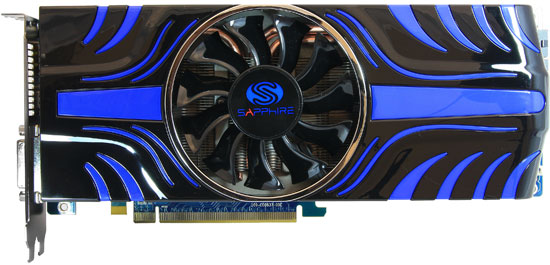
Diving right in to things, the most distinctive feature of course is the cooler on the Toxic. It’s one of Sapphire’s trademark vapor-chamber coolers as found through their entire Vapor-X/Toxic line, and is designed to be more efficient and quieter than the standard heatpipe-only coolers found on reference cards. Compared to the reference cooler it’s also open-ended, meaning unlike the reference cooler it’s not a blower that exhausts all air outside the case. Rather with a large, centered fan, the Toxic’s cooler pushes air out both the front and the rear of the card.
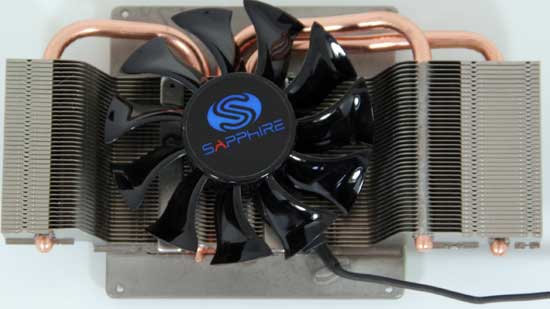
Cracking open the cooling apparatus we find a fairly large heatsink with 3 heatpipes embedded in it, running down to the vapor chamber in the base plate. The use of 3 heatpipes means the heatsink is asymmetrical, with more pipes going to towards the rear of the card than the front.
With the cooler removed, we can see the rest of the custom kit on the Toxic: the custom PCB and chokes. Right away you’ll notice that Sapphire’s custom PCB is longer than the stock PCB; 10.1” versus 9.5”. The result of this is not only more space that Sapphire has filled with capacitors and chokes, but the entire board is basically shifted to the right compared to the reference board. Meanwhile we can see Sapphire’s custom “Black Diamond” chokes, which are grooved for better airflow and heat dissipation.
One particularly interesting deviation from the reference design is that rather than trying to attach the main VRMs to the cooler, Sapphire has given the VRMs their own small heatsink. This heatsink sits below the larger heatsink attached to the GPU, and catches airflow from the fan bound for the rear of the card. Based on our past observations, the cooling on VRMs on the reference 5800 and 5900 designs has been sketchy – for our 5970 in particular we found that the VRMs would overheat under a modest overclock. Our 5850 reference samples have not provided similar problems thanks to the lower operating voltage of a 5850, but this should still prove to be a better method of cooling the VRMs than the simple metal bar on a reference 5850.
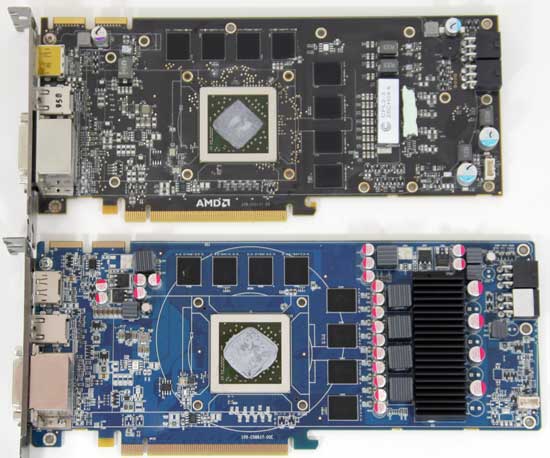
The fact that the card deviates this much from the AMD reference design means that some considerations need to be taken in to account compared to the 5850. At around 0.5” longer than the reference design, the Toxic can get close to impeding whatever may lie behind the card. Sapphire kept the 5850’s rear-facing PCIe power plugs rather than going with 5870-style top-facing plugs, so you have to factor in the additional space required by the cables. In our Spedo case, this is as long as a fully installed card can get without running in to the case fan behind the video card.
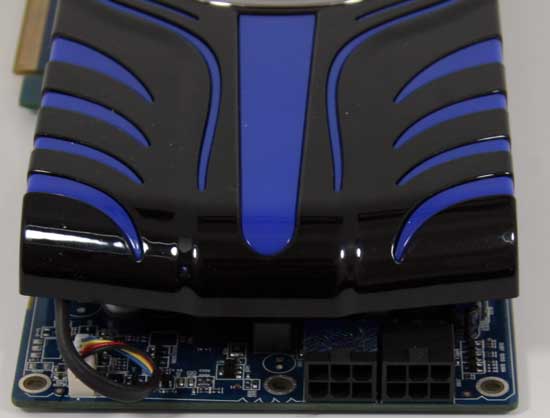
The open-ended design also changes cooling considerations slightly. With the card venting hot air out the rear of the card along with the front, we found having a fan behind the card to feed it fresh air to be counter-productive – we were better off removing the fan and letting the card blow air back. On the plus side, the fact that the cooler on this card is open-ended on both sides means that unlike the full sheath on the reference card, this card is compatible with tool-less locking mechanisms such as what’s on our Spedo case.
Moving on, besides the card the rest of the package is unremarkable. The card comes in a full size box, which contains a manual, driver CD, a mid-length Crossfire bridge, a DVI-to-VGA adaptor, and a pair of molex-to-PCIe power adapters. Sapphire doesn’t make their own set of overclocking tools, and with the 5850’s overdrive limit of 775/1125, you’ll need 3rd party tools to do any serious overclocking.
A Quick Note on AMD & Factory Clocks
While we were talking to Sapphire about the Toxic 5850, we asked them whether we would be seeing a Toxic 5870 to complement the 5850. We got a surprising answer and an even more surprising reason behind it that we’d like to share with you.
Sapphire will not be producing a 5870 Toxic, and the reason for that is that AMD won’t let them (or anyone else) offer a factory-overclocked card that runs significantly faster than their existing Vapor-X card (875MHz). This apparently isn’t a huge secret, but this is the first time we’ve heard this.
When we asked AMD about this, they told us that this all boils down to what AMD believes is safe operation for their chips. AMD allows vendors to factory overclock their chips to whatever point AMD feels is as high as they can safely go, and no higher. If any significant number of them could go higher, then AMD would have released them as a higher-end bin.
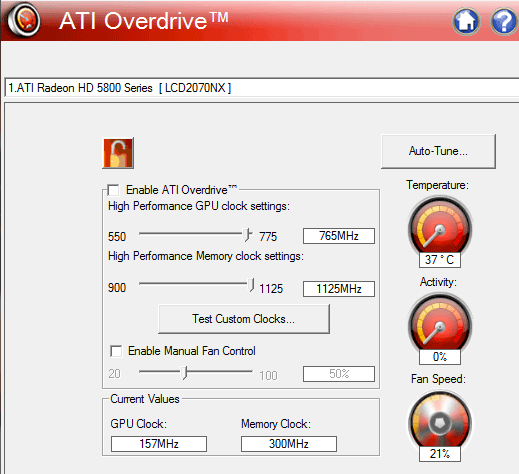
This put’s AMD’s limits at around 875MHz for the 5870, and 765MHz for the 5850. Note that AMD’s Overdrive limits are still higher than this, particularly on the 5870 where Overdrive goes to 900MHz. In practice we were able to get our 5850 Toxic to 895MHz without any kind of voltage adjustment, so even with some breathing room we believe that Cypress chips assigned 5850 status for defective unit reasons (that is, it’s not a 5870 because it has a defective SIMD) are plenty capable of going higher. Particularly with Sapphire’s Vapor-X cooler, the heat isn’t an issue.
The Test & Results
Sapphire’s 5850 Toxic edition is clocked at 765MHz/1125MHz, a 5.5%/12.5% overclock on the core and memory respectively. So performance compared to a reference 5850 can be anywhere between no improvement (CPU limited) to a full 12.5% improvement if the bottleneck is memory bandwidth. This of course will vary from game to game.
| CPU: | Intel Core i7-920 @ 3.33GHz |
| Motherboard: | Intel DX58SO (Intel X58) |
| Chipset Drivers: | Intel 9.1.1.1015 (Intel) |
| Hard Disk: | Intel X25-M SSD (80GB) |
| Memory: | Patriot Viper DDR3-1333 3 x 2GB (7-7-7-20) |
| Video Cards: |
AMD Radeon HD 5970 AMD Radeon HD 5870 AMD Radeon HD 5850 AMD Radeon HD 5770 AMD Radeon HD 5750 AMD Radeon HD 5670 512MB AMD Radeon HD 4890 AMD Radeon HD 4870 1GB AMD Radeon HD 4850 AMD Radeon HD 3870 AMD Radeon HD 4770 AMD Radeon HD 4670 512MB NVIDIA GeForce GTX 295 NVIDIA GeForce GTX 285 NVIDIA GeForce GTX 275 NVIDIA GeForce GTX 260 Core 216 NVIDIA GeForce GTS 250 NVIDIA GeForce 8800 GT |
| Video Drivers: |
NVIDIA ForceWare 190.62 NVIDIA ForceWare 195.62 AMD Catalyst Beta 8.66 AMD Catalyst Beta 8.66.6 AMD Catalyst 9.9 AMD Catalyst Beta 8.69 |
| OS: | Windows 7 Ultimate 64-bit |
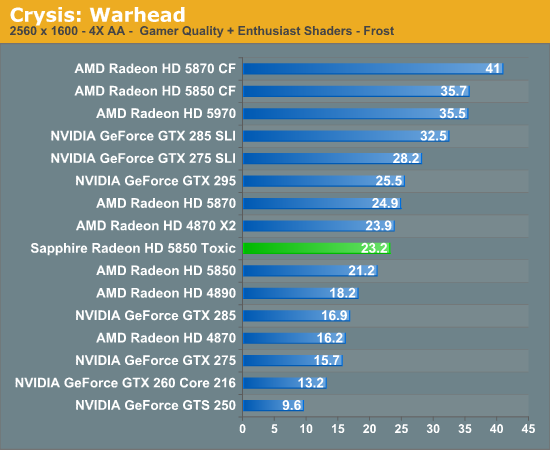
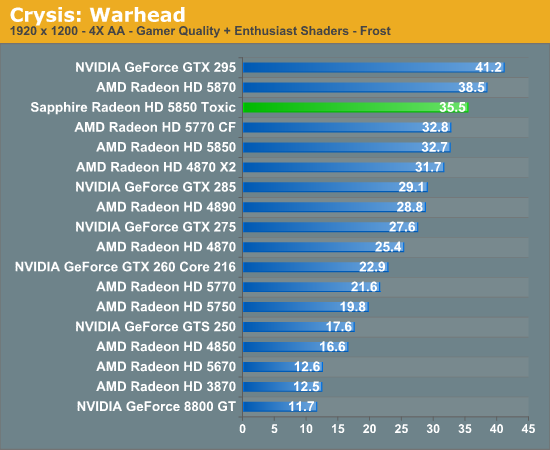
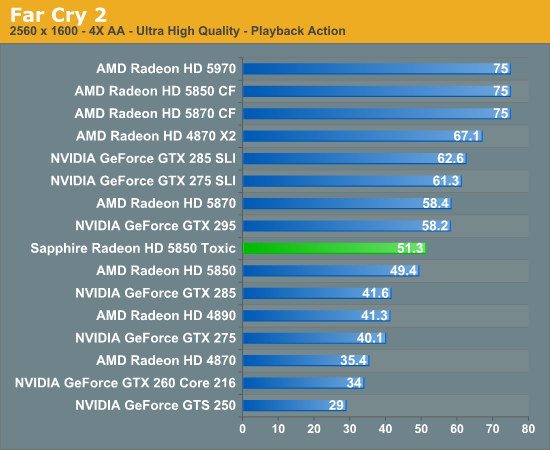
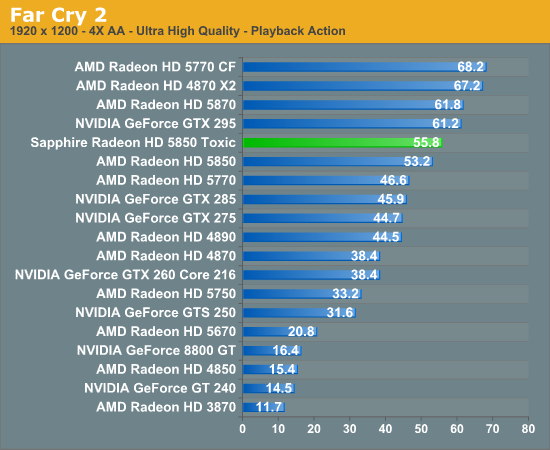
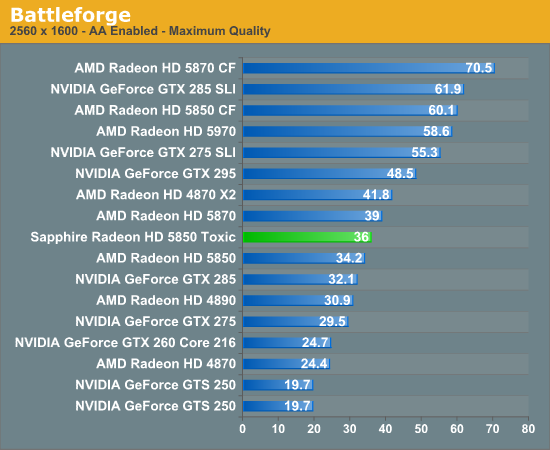
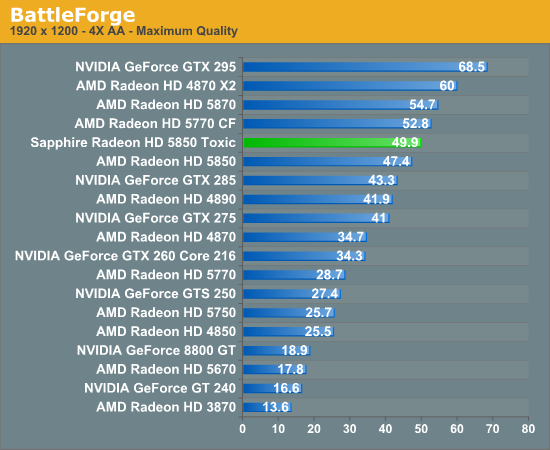
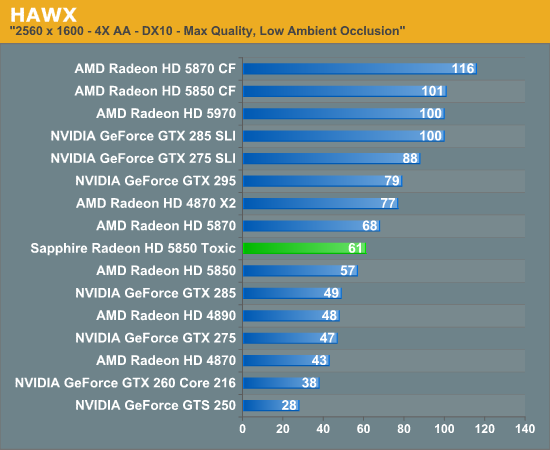
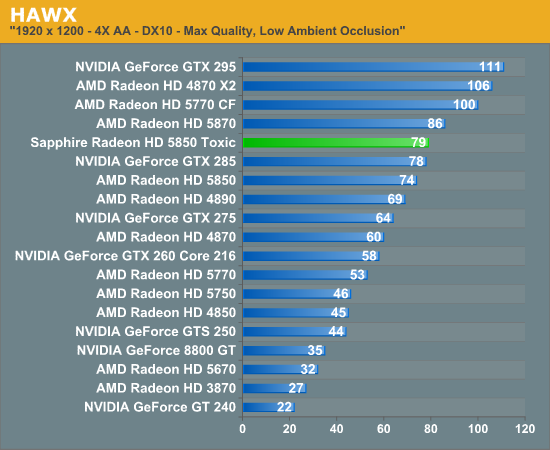
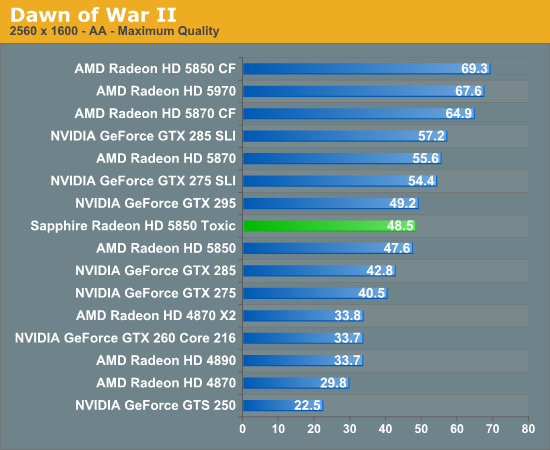
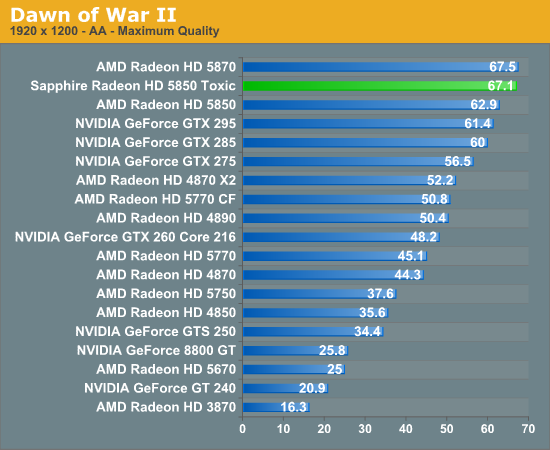
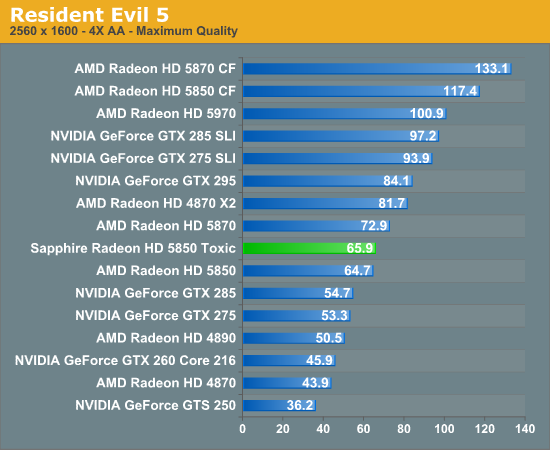
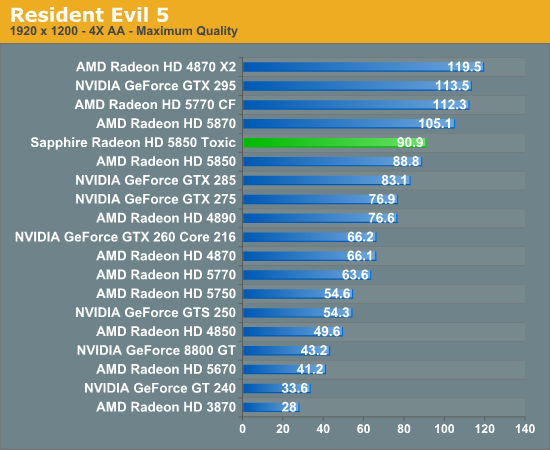
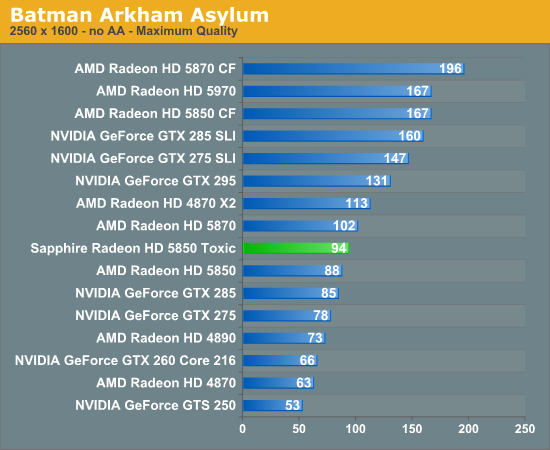
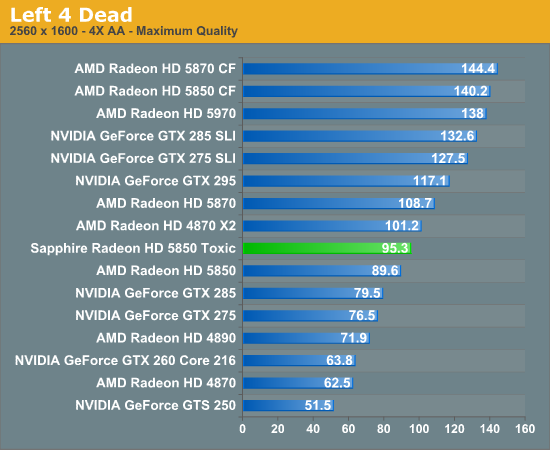
The difference, as we expected, is varying from game to game. The factory overclock on the 5850 Toxic isn’t enough to significantly shift the performance of the card, but it’s enough for 5-10% better than a stock-clocked 5850.
Overclocking
With Sapphire’s superior Vapor-X cooler, the 5850 Toxic is a strong candidate for overclocking. However currently none of our overclocking tools know how to overvolt the card, so any overclocking is limited to what you can get at the 5850’s stock voltage: 1.088v.
With that in mind, we were able to use the AMD GPU Clock Tool to push our card by a further 130MHz on the core to 895MHz, and an additional 50MHz on the memory to 1175MHz. This is 17% core overclock and 4% memory overclock respectively. Thus unlike the already overclocked Toxic card, the games that will respond the best here are those that are GPU limited instead of memory bandwidth limited.
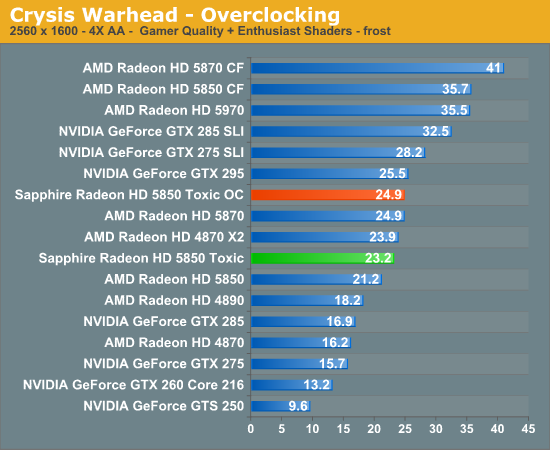
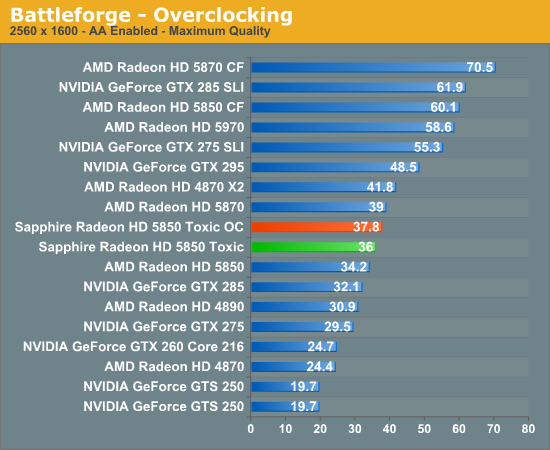
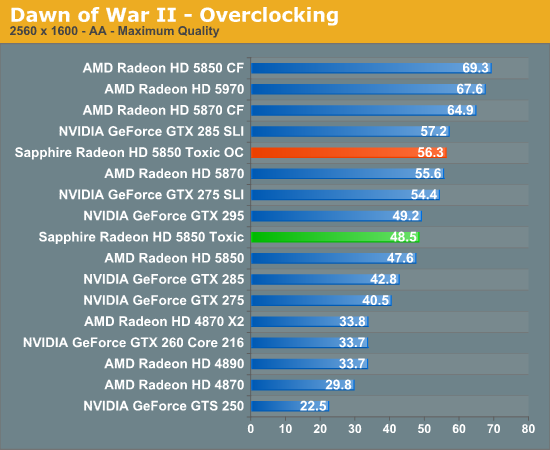
Out of the 3 games we’re taking a look at for overclocking results, the benefit varies wildly. Battleforge is rather insensitive at only a 5% performance increase, while Dawn of War II is nearly linear with the GPU clockspeed increase, for 16%. Thus our results are much like the benefit of Sapphire’s factory overclock in the first place: there’s no rule of thumb, the benefit of overclocking is going to vary wildly depending on the game.
We should note that at these clockspeeds we’re some 23% faster than the 5850’s GPU clock speed, and 17% faster than its memory clock speeds. Thus at these maxed out levels, our further overclocked 5850 Toxic is 17% faster at Crysis, 10% faster at Battleforge, and 18% faster at Battleforge. What’s particularly noteworthy is that the overclocked Toxic actually manages to best the 5870 here, even though the 5870 has another SIMD to work with. This indicates that Battleforge it bottlenecked by the ROPs, or at some point in the fixed-function pipeline.
Temperature, power, and noise results for our overclocked 5850 Toxic are on the next page.
Power, Temperature, & Noise
On the one hand, by overclocking this card Sapphire has ultimately increased the power draw of the card and the amount of heat it will be generating. On the other hand with the Vapor-X cooler, they’re better equipped to siphon out that heat, and to do so without making much in the way of additional noise. So let’s see how things pan out.
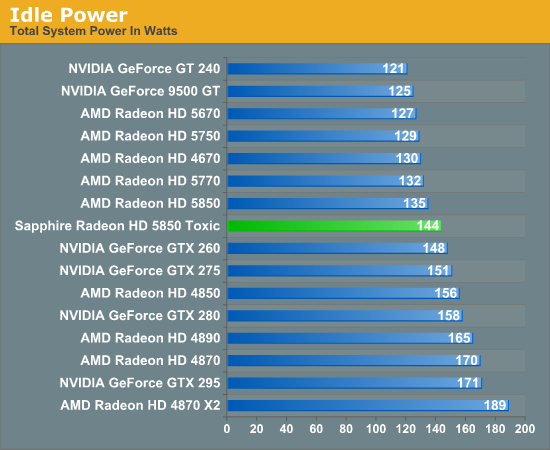
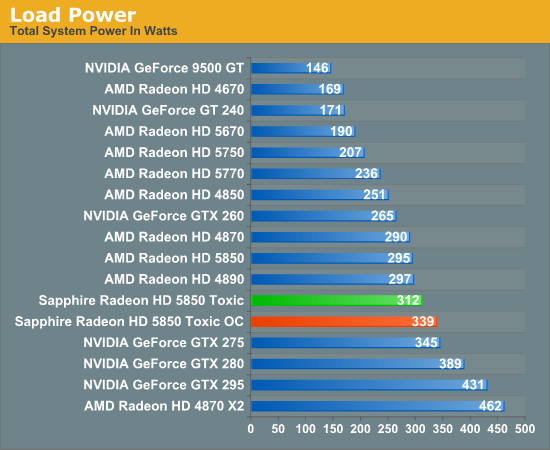
Right off the bat, the Toxic is at a disadvantage for power usage as we expected. At idle it operates at the same voltages and clocks as a reference 5850, so our 9W difference ultimately comes down to board differences; remember, the Toxic has a number of additional components compared to the reference card, particularly capacitors. Under load the difference is 17W, due to a combination of components and clock speeds. This is ultimately in-line with where you’d expect it to be based on the higher clock speeds.
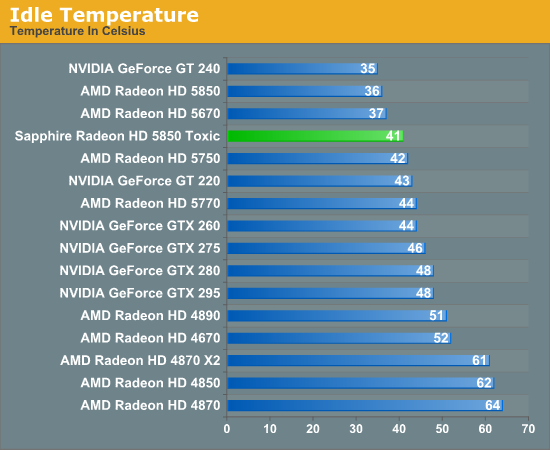
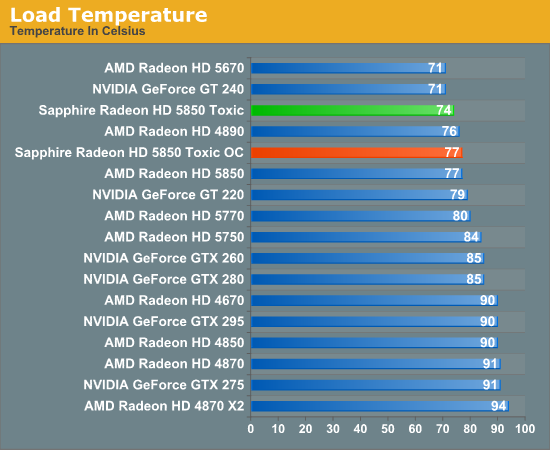
Moving to temperature, we can see the difference the Vapor-X cooler makes. The 5850 was always a particularly cool card, and surprisingly the Toxic does worse here. We’re measuring the temperature of the GPU, so any extra heat produced by the Toxic’s component selection shouldn’t be factoring in. The difference likely comes down to the coolers – a shrouded blower that fully exhausts hot air looks to be a more efficient option under these circumstances.
It’s under load where the Vapor-X cooler on the Toxic shines. Even though the card is overclocked and drawing an additional 17W, it still bests the reference cooler by 3C. It’s not a massive amount, but then again it’s only 3C warmer than even the 5670.
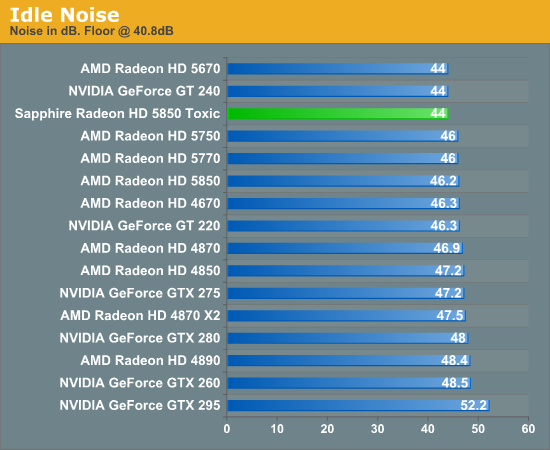
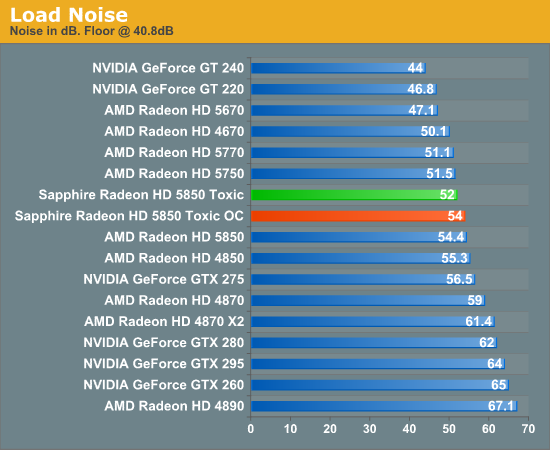
So the reference 5850 cooler may be a bit better at keeping temperatures down at idle, but it’s not the quietest option. Here the Toxic can do 2dB quieter. It’s a similar story under load, where it’s 2.4dB quieter than the reference cooler, and once again take in to consideration the fact that the Toxic is dispersing 17W of additional heat in the process.
As for our fully overclocked Toxic, the 895MHz/1175MHz clocks push power consumption up by another 27W to 339W under load. Even with the now 44W difference between it and the reference 5850, the noise generated by the Toxic and the GPU temperatures are in a dead-heat with the much slower reference 5850. There’s no question that the Toxic’s Vapor-X cooler is a superior cooler, and this leaves us wondering just how much more it can take if we could overvolt the GPU.
Conclusion
Vendor overclocked cards tend to throw a wrench in to our recommendations due to their very specific price points and the fact that they’re often just “X but 5% faster” products, leaving us with little to say about the product. Thankfully Sapphire’s 5850 Toxic Edition is not one of those cards.
Sapphire’s Vapor-X cooler is once again a tangible benefit to the product. Their marketing literature ultimately overstates the benefit by claiming that they can get upwards of a 15C and 10dB improvement in temperature and noise respectively, but it’s clear that it’s still a better cooler than our reference cooler. It’s not a night-and-day difference, but it’s better.
As for the custom board, it’s not as strong of a selling point. On a professional level we’re interested in it because after 5 months it’s the first thing we’ve seen that’s different from a reference 5850. From a feature and value standpoint however it’s a wash. The extra idle power usage is 9W over a reference card that only consumes 27W idle power, so the 5850’s amazingly low idle power usage takes a hit of 33%. We would have also liked to see the PCIe power plugs get moved up top, since the card surpassed 10” in length.
On the plus side, we’re quite happy to see a real heatsink setup for the 5850’s VRMs. The 5850 really isn’t the right card to benefit from it (particularly when we can’t overvolt it) given that the 5850 doesn’t drive the VRMs especially hard, but it’s a series-wide weakness that we’re glad someone took care of. We’ll hold off on talking about overclocking for now since we haven’t seen any other vendor’s 5850s (particularly those with overvolting options) and our own 5850 reference cards are especially poor overclockers. To that end we don’t have enough data (or really any good way to collect it) to quantify any possible advantages of the Toxic’s custom board – all we can tell you with absolute certainty is that it’s big and it’s blue.
Throwing out the custom board for a moment, between the Vapor-X cooler and the factory overclock the 5850 Toxic Edition is clearly superior over the reference 5850 for most purposes. Sapphire told us that the MSRP on the Toxic is $319, which at today’s average 5850 price of $299 puts it at a mere $20 over those reference cards. For a 6.5% increase in price we get around that much of an improvement in performance and a better cooler, and that would make the Toxic an easy card to recommend.
Instead, like virtually every other 5800-series product, the card is selling for above MSRP. Right now the Toxic is going for around $339, which makes it $40 (or 13%) more expensive than a reference 5850. This is still below the 5870 by a wide margin, but it puts it at the top of the 5850s in terms of price. At $339, it’s not the steal that it was at $319. It’s the best you can do if you can’t afford a 5870, otherwise the price gap is a bit much. Since it was just launched, we’d recommend waiting a week or two and see if the price stays that far above MSRP.
In the absence of enough data to work with to properly compare the overclocking capabilities of the 5850 Toxic Edition or to quantify the benefits of a custom board, the only thing we can really work with is the factory overclock, the Vapor-X cooler, and the price. The 5850 is already a fairly cool card, so while the Vapor-X cooler is superior to the reference cooler, it’s not enough of a reason on its own to justify the Toxic. But if you take that in to consideration with the factory overclock and the price, if the actual retail price of the Toxic can come closer towards the MSRP and the existing reference cards, then Sapphire would have a sure winner on their hands.

